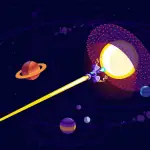Key takeaways
- The star HD 158259, located 88 light-years away, is orbited by six planets, making it a unique find. The star is similar in mass to the Sun but slightly larger. Its planets include one super-Earth and five mini-Neptunes.
- After seven years of observation, scientists found that the planets orbit HD 158259 in nearly perfect orbital resonance. This means their orbits are closely linked, with each planet’s orbit influencing the next.
- Each planet around HD 158259 is in almost a 3:2 resonance with the next, meaning for every three orbits one planet completes, the next planet out completes two. The period ratios of the planets are very close to 1.5.
- The precise resonance suggests these planets did not form in their current positions. They likely formed further from the star and migrated inward, maintaining their resonances as they moved. This process helps us understand how planetary systems form and evolve.
- The small deviations from perfect resonance can provide valuable information about the planets’ internal structures and the dynamics of their migration. Further research and modeling could reveal more about the history and formation of this remarkable system.
We have discovered hundreds of stars with numerous planets distributed around the cosmos. Each one is distinct, but the system circling the star HD 158259, located 88 light-years distant, is absolutely exceptional.
The star is around the same mass and somewhat bigger than the Sun, making it a rare find in our search for exoplanets. It is orbited by six planets: one super-Earth and five mini-Neptunes.
After seven years of tracking, scientists determined that all six planets orbit HD 158259 in nearly perfect orbital resonance. This revelation may help us better understand the mechanics of planetary system formation and how they result in the configurations we observe.
Orbital resonance occurs when the orbits of two bodies around their parent body are tightly coupled, with the two orbiting bodies exerting gravitational impact on one another. It is quite uncommon in planetary bodies in the Solar System, with Pluto and Neptune serving as prime examples.
These two entities are in what is known as a 2:3 orbital resonance. Pluto makes two rounds around the Sun, whereas Neptune does three. It’s like playing two bars of music at the same time, but with distinct time signatures – two beats for the first, three for the second.
Orbital resonances have also been discovered in exoplanets. However, each planet circling HD 158259 is in almost 3:2 resonance with the next planet away from the star, commonly known as a period ratio of 1.5. That is, for every three orbits a planet makes, the following one out completes two.
Using observations from the SOPHIE spectrograph and the TESS exoplanet-hunting satellite telescope, a multinational team of researchers led by astronomer Nathan Hara of the University of Geneva in Switzerland was able to correctly compute each planet’s orbits.
They’re all really close. The orbits begin closest to the star – the super-Earth, which TESS discovered to be around twice the mass of Earth – and last 2.17, 3.4, 5.2, 7.9, 12, and 17.4 days.
These result in period ratios of 1.57, 1.51, 1.53, 1.51, and 1.44 for each pair of planets. That isn’t exactly perfect resonance, but it’s near enough to qualify HD 158259 as an outstanding system.
And this, the researchers believe, indicates that the planets circling the star did not develop where they are presently.
“Several compact systems with several planets in, or close to, resonances are known, such as TRAPPIST-1 or Kepler-80,” revealed University of Geneva astronomer Stephane Udry.
“Such systems are thought to develop distant from the star before migrating to it. The resonances play an important role in this scenario.
This is because these resonances are expected to occur when planetary embryos in the protoplanetary disk mature and move inward, away from the disc’s outer edge. This results in a chain of orbital resonances across the system.
Then, when the residual gas in the disc diminishes, the orbital resonances can become unstable, which might be what we’re witnessing with HD 158259. And the slight changes in orbital resonances might reveal more about how this destabilisation occurs.
“The current departure of the period ratios from 3:2 contains a wealth of information,” Hara stated.
“Using these numbers and tidal effect models, we might restrict the interior structure of the planets in a future research. In summation, the current condition of the system provides insight into its genesis.”
The findings have been published in Astronomy & Astrophysics.

